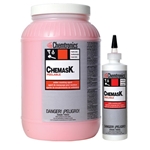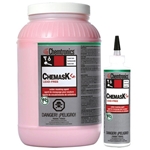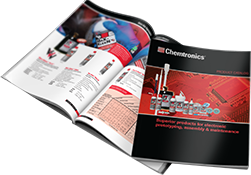Ultimate Guide to Temporary Solder Mask
What is Temporary Solder Mask
Temporary solder mask (also called “spot mask”) is used every day in the assembly of electronic circuit boards. Solder mask is engineered to protect thru-holes or “vias” in wave soldering. It has to withstand extreme soldering temperatures and still be removed easily and efficiently at the end of the PCB assembly process.
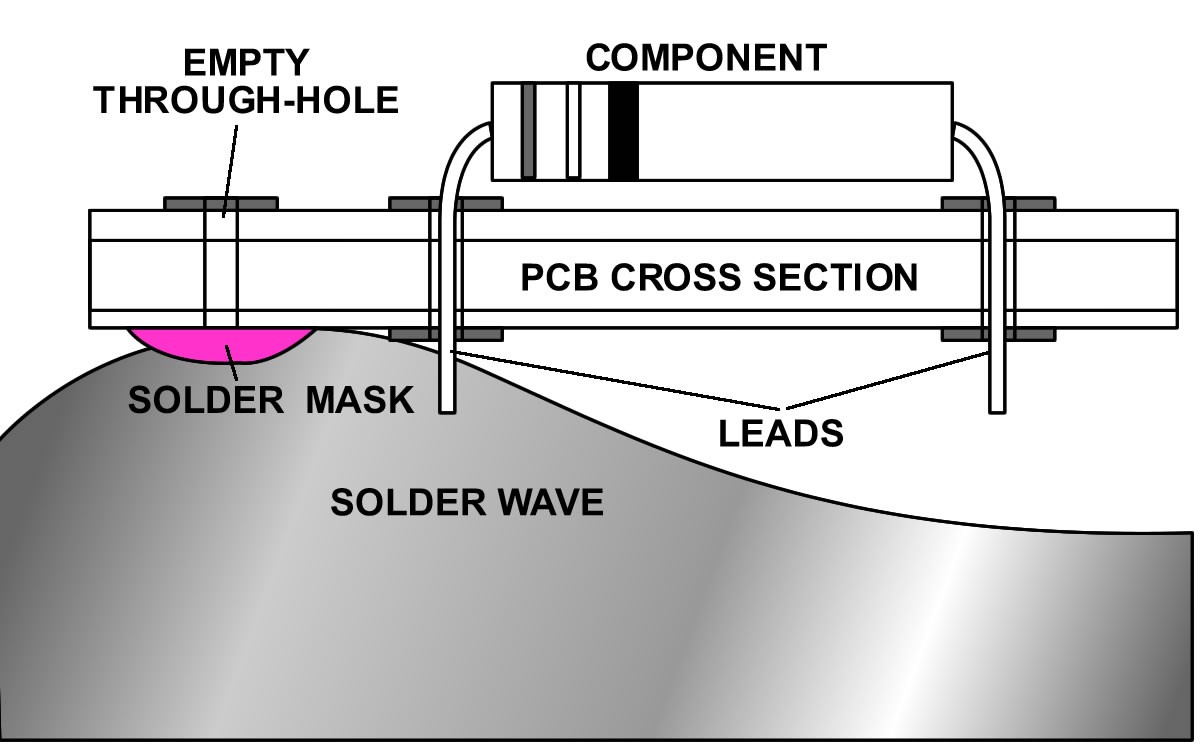
If you are spraying or dipping conformal coating, mask can be used to protect connectors and other areas that can’t be coated.
Not to be confused with “permanent” solder mask, commonly known as solder resist, temporary solder mask is engineered to be removed. Temporary solder mask is an essential tool for automated soldering processes.
Chemask® Solder Mask protect PC boards, plated thru-holes, contacts, pins, posts, terminals and gold fingers during wave soldering. They provide short-term high-temperature protection from molten solder. All Chemtronics solder masks are nonflammable, non-contaminating and will not leave ionic or corrosive residue. Chemask® Solder Masks are available in convenient squeeze bottles for a precision application or in gallons for automated applications.
What are The Common Uses for Temporary Solder Mask?
- Masking open PCB thru-holes in wave soldering process – This is the most common use for spot mask. Circuit boards are often designed to work within multiple different product models, so different feature sets may require some areas to be populated and others unpopulated. To make sure these open vias stay open, and not soldered in the wave soldering process, mask is applied over the open areas. This is needed because the wave soldering process isn’t discriminating, so it will solder anything that is metal and fluxed. Solder will not stick to mask, however, so the area underneath will be unaffected.
- Masking contact areas or solvent sensitive components – When applying conformal coating to a circuit board, it is important to avoid contact areas. Coatings are generally insulative, so will impede the function of contacts, switches, and anything else that requires metal-on-metal contact. Components that are solvent sensitive or have moving elements may also need to be masked. This is less of an issue when using a selective spray system, but if applying coating from an aerosol can, or through a hand sprayer or dipping process, masking is often required.
- Damming around low stand-off components – SMT (surface mount technology) and BGA (ball grid array) components often have very low stand-off areas, the space between the component and the surface of the board. Even when applying conformal coating with a selective spray system, you run the risk of material being drawn under the component through capillary action. For some designs, this may be problematic, so mask can be used to surround the component, creating a dam.
- Temporary adhesive for soldering double-sided SMT PCBs – A significant challenge of assembling double-sided SMT circuit boards is how to solder components on the bottom-side of the board. Running the top-side of the board through the reflow oven isn’t a problem because gravity helps hold the components in place as the solder melts and then solidifies. When the board is flipped to run the bottom side, you are counting on the surface tension of the solder to hold the components into place. That may work for smaller components, but some type of adhesive might be needed to hold larger components in place. Spot mask is often applied to the corners of BGAs and other large components.
- Protecting temperature sensitive components in the reflow process – Because latex mask is thermally insulative, engineers have found a creative way to use it to protect heat sensitive components as they run though the reflow process. Since this goes far beyond the intended purpose of temporary solder mask, manufacturers of the material will probably be of little help qualifying the product.
- Masking areas in painting, powder coating, or plating process – If you picture temporary solder mask as liquid masking tape, it opens up a world of potential applications. Again, outside the intended purpose, so you will need to test and qualify for yourself.
Why Should I Use Spot Mask Instead of Kapton tape or a masking boot?
Besides temporary solder mask, Kapton tape (popular E.I. du Pont de Nemours brand name of heat resistant polyimide tape) or pre-formed silicone masking boots are commonly used to cover select areas of the circuit board. Polyimide tape is popular because it is readily available and applies quickly, without worrying about cure time. A boot simply snaps onto the area to be masked. The main advantage of solder mask over these other methods is flexibility. Tape generally comes in rolls or die-cut shapes, which may work perfectly for most areas, but there are always those special circumstances. In addition, the adhesive on tape can leave residue behind that can create wetting issues for conformal coating. Masking boots are preformed, which requires more planning and lead time than many contract manufacturers can afford. Boots also need to be cleaned as they are coated with baked-on flux, or discarded.
How Do You Apply Temporary Solder Mask?
The main methods to apply temporary solder mask are by hand, generally with a squeeze bottle or tube, with pneumatic system, or stenciled.
Manually / hand application
This application method is as simple as it sounds. You squeeze the bottle to apply the mask to the areas that need protection. Believe it or not, the way you hold the bottle can make a big difference on how easily the cured mask is removed.
Many operators hold the bottle at a 90° angle as they drag the dispensing tip across the area they are masking. This has a tendency to force the mask through the vias and causes 3 potential problems:
- The mask tends to stick to the inside of the thru-holes, and may push out the other side and mushroom out. This creates a plug on the other side, which increases the chance of breakage when peeling off the cured mask.
- The material inside the thru-holes are less accessible if washing off mask in an aqueous cleaning system.
- The bead of mask is thinner when holding the bottle at 90°. When using a peelable mask, this bead acts as a draw-string, so a thinner strip has more of a tendency to become brittle in high soldering temperatures, and is more likely to break when removing the cured mask.
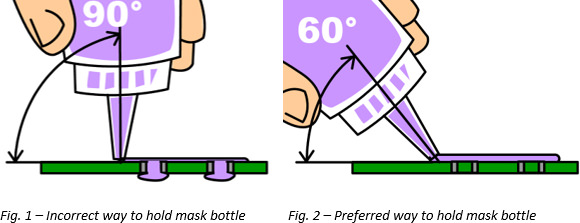
Pneumatic Dispensing
In a pneumatic dispensing system, the mask is pressurized with either compressed air or nitrogen and forced out of a dispensing tip or needle. Take care that you use a mask with a low shear cure. A high shear curing mask experiences accelerated curing when pressure is applied. As the mask is forced through the dispenser, pressure will increase, which will tend to clog the tip or needle.
Another potential area of concern is whether or not the mask is curing in the tank. If the mask skins over in the tank, and those cured pieces are drawn through, it could clog the dispensing tip. Pressurizing with nitrogen can help alleviate this problem. If there is skinning in the tank or in the original mask container before the material is transferred, it is important to remove the cured material, not mix it into the mask.
Most solder masks can be thinned with DI (deionized) water to reach the optimal viscosity. Mix carefully to avoid whipping and introducing air bubbles into the mix. If you do, you’ll regret it once the mask is brought to soldering temperature and the trapped gas wants to escape.
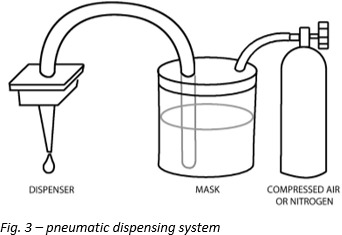
Stencil Printing
Mask can be applied with a stencil in a similar process as printing solder paste in a surface mount assembly process. Of course, this process is only feasible when there is a flat surface. When selecting a mask for stencil printing, make sure the viscosity if high enough to be controlled and not drawn under the stencil through capillary action. Also think through how the stencil will be cleaned. Choosing a washable mask makes this a more straightforward process. A peelable mask can be used, but you will either have to clean the stencil while the mask is still wet, or you will have to physically peel off the cured material. This is especially important when printing through a screen (i.e. screen printing). Screen printing should be avoided with very fine mesh screens because of the cleaning challenges.
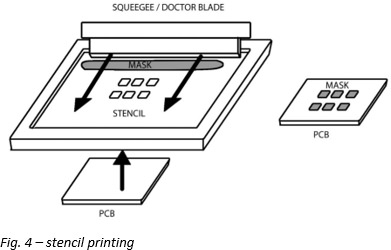
How Do You Use Temporary Solder Mask for Conformal Coating?
If you think of spot mask as basically liquid masking tape, the application become more intuitive:
- Apply the mask to the contact areas to protect. Allow mask to fully cure.
- Apply the conformal coating.
- After the coating is dry to the touch, but before it is fully cured, peel off the mask.
Here a few things to consider:
- Peelable mask is recommended. Since conformal coating is generally hydrophobic (repels water), it will be difficult to wash off mask under a coating layer.
- Natural latex is recommended, because synthetic mask can sometimes interact with harsh solvents used in conformal coating.
- For the cleanest masked edge, peel the mask before the coating is fully cured. Otherwise it could create a cracked, ragged edge, or even pull up the coating.
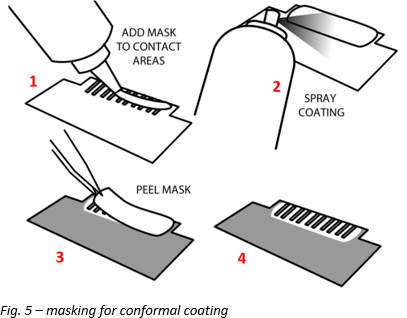
How Do You Remove Spot Mask?
Peelable mask is usually removed by hand or with tweezers. Resourceful engineers have come up with devices with rotating brushes and other creative methods, but there is no commercially available equipment to speed this process along.
Washable mask is engineered to be removed in an aqueous inline or batch wash system. If you are using a closed-loop system, which filters and recirculates wash water, make sure you use a mask that is compatible with your physical filters and ion beds. If you experience foaming, it is an indication that either too much mask material is being passed back into your cleaning system or it is interacting with dissolved flux in the same wash water. This is generally solved by replacing your wash water with fresh DI water, but a defoaming agent can be added as a stopgap solution.
Can Solder Mask be Left on the Circuit Board?
Temporary solder mask is intended to be just that – temporary. Manufacturers of solder masks, like Chemtronics, always recommend removing the mask because there is no testing to support doing otherwise. If you decide to leave the solder mask on as a permanent part of the PCB, you will have to do your own functional and reliability testing to ensure it does not cause a problem.
How Long Should I Cure Temporary Solder Mask?
The curing step is the bottleneck of the masking process, so it will always be tempting to push the PCB through sooner rather than later. Mask cures from the outside-in, so it skins over, and then cures on the inside. This can take anywhere from 30 minutes to 24 hours depending on the type of mask and the thickness of the bead.
When uncured mask hits molten solder, the liquid components of the mask instantly vaporize and, if the cured skin is not thick enough, will forcefully exit. This will create voids in the mask and, in extreme cases, lift the board out of the solder and throw solder beads all over the PCB. Not good!
The wave solder pre-heat zone does provide a margin of error, but it is not recommend for doing all the curing. The mask may not need to be fully cured when it is put on the wave conveyor, but it should be cured to the touch with a firm skin. Beyond that, you will need to test within your own process because it depends on the mask material, the thickness of the bead, and the thermal profile.
How High of a Temperature Can Temporary Solder Mask Withstand?
Solder mask is engineered to withstand molten solder temperature for the very brief time (about a second) it is exposed in a typical wave soldering process. Most commercially available masks should be able to withstand melting point temperatures of lead-based and lead-free solder, up to 650°F (343°C). As exposure time is lengthened, like in a reflow oven, there is more potential the mask will bubble, char, and become brittle. How long a mask can withstand extreme temperatures depends on the thickness of the bead, and the type of mask.
Can Spot Mask Run Through SMT Reflow?
When mask is run through a reflow soldering process, it is not only exposed to extreme temperatures, but also for a longer period of time compared to wave solder. This increases the risk the mask will bubble, char, and become brittle. How long a mask can withstand extreme temperatures depends on the thickness of the bead, and the type of mask. Natural latex is generally recommended for reflow. Synthetic materials will tend to become brittle, and washable masks will be very difficult to remove.
How Do I Select The Best Temporary Solder Mask for My Application?
There are several factors to consider when selecting a solder mask:
Removal Method
The first decision when selecting a solder mask, is figuring out how it will be removed.
If you currently run your PCBs through a batch or in-line wash system, you have the option to use a water-washable mask. Chemask® WF can be removed in a batch or inline cleaning system, and will not clog filters or damage ion filter beds.
Chemask® WF Solder Masking Agent is a high-temperature temporary spot mask that protects component-free areas from molten solder during wave soldering. It is water soluble, designed to be removed with open and closed loop aqueous cleaning systems. Chemask WF is low foaming and has no effect on deionized water (DI) system resin beds. This water-soluble formulation is stable to rosin, organic and inorganic fluxes.
If you use solvent cleaners, or don’t clean your boards at all, peelable masks are your best option.
Peelable solder masks are commonly used in no-clean soldering environments or by PCB assemblers that clean with solvents. Peelable masks are commonly used for masking contact areas and over chemically sensitive components in conformal coating processes.
Sensitive Metals
Chemask® NA is a non-ammoniated masked that has low odor and is safest on sensitive metals like copper.
Chemask NA Non-Ammoniated Solder Masking Agent is a latex and ammonia free, fast curing, peelable temporary spot mask formulated for safe use on sensitive metals. It contains high-temperature resistant compounds that protect component-free areas during wave soldering. Chemask NA may be used to protect pins, posts, contacts and edge connections in the solder reflow oven or during conformal coating processes.
If you are looking for a strong peelable mask that is the easiest to remove, check out our natural latex masks like Chemask Peelable, our best-selling mask.
Masking for Conformal Coating
Chemask® Peelable is ideal for masking areas from conformal coating.
Chemask is a fast curing peelable solder masking agent. It contains natural latex formulated with high-temperature resistant compounds that protect component-free areas during wave soldering. Chemask may be used to protect pins, posts, contacts and edge connections during conformal coating processes.
Masking Large Vias
Chemask® HV is a high viscosity version that works well for masking large vias.
Chemask HV Solder Masking Agent is a temporary, high viscosity, fast curing, peelable solder masking agent. It is a high-temperature resistant compound that protects component-free areas during wave soldering. Chemask HV can be introduced to the wave solder preheat within 4 minutes without adverse effects. Chemask HV may be used to protect pins, posts, contacts and edge connections during conformal coating processes.
High Temperature Soldering
Chemask® LF is engineered to withstand the higher temperatures of lead-free soldering.
Chemask Lead-Free Solder Masking Agent is a temporary, fast curing, peelable solder masking agent formulated for use in high-temperature lead-free applications. It is a temperature resistant coating that protects component-free areas of the PCB during wave soldering. Chemask Lead-Free can be introduced into the preheat oven within 4 minutes of application without adverse effects. Use to protect pins, posts, contacts and edge connections during conformal coating processes.
Contact us at +31 088 130 7400 or chemtronics@itw-cc.com and we can help you find the best temporary solder mask for your requirements.

